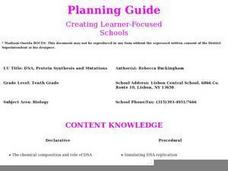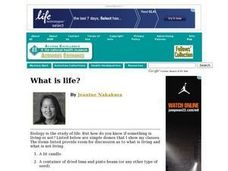Curated OER
Wellness and the Organic Food Movement
Twelfth graders examine their activities and discuss how they impact the environment. In groups, they research the organic food movement and discuss how it changed the type of foods eaten. To end the lesson plan, they examine the...
Curated OER
Harvest of Fear
Students research and debate the pros and cons of genetically altered foods. Students discuss whether they would be willing to eat genetically modified foods and whether these foods should be allowed to be created.
Curated OER
Breaking News: GM Cows to Produce Human Breast Milk
Students explore current events by reading and analyzing an article in class. In this human diet lesson plan, students read an article about cows which are being genetically modified in order to produce human breast milk for consumption....
Curated OER
Catch Up On Tomato Technology
Students explore the ways in which technological advances have benefited tomatoes as a commodity. In a small group, students review information related to the selective breeding and genetic engineering of tomatoes. Groups compose a...
Curated OER
Peanut Butter Broccoli
Students explore selective breeding and genetic engineering. They illustrate that produce items have a wide variety of traits that can potentially be combined to produce a new food by creating a class graph.
Curated OER
Rennet Cultured Cheese
Fifth graders make cheese using two different methods. In this cheese making lesson, 5th graders make rennet cultured cheese following the step by step directions. They also make cheese using a genetically engineered bacteria that makes...
Curated OER
Kernels of Wisdom: Investigating Natural Variations in Corn
Here is a brain-popper! Corn, or more appropriately, maize, was intentionally domesticated by humans around 9,000 years ago and over a period of hundreds to thousands of years! Genetics and botany researchers have collaborated to find...
Curated OER
Evolution of Biotechnology Timeline
Learners explore how present biotechnology has evolved. They create a timeline is included referencing major scientists and major events in history which have led to our current understanding and use. A teacher time line is included.
Virginia Department of Education
Biotechnological Issues and Bioethics
Culminate a bioethics unit with the implementation of a lesson plan that incorporates the Socratic method to encourage class feedback and participation. Pupils participate in a discussion on bioethics and morality, complete a writing...
Curated OER
Temperature and the Tomato
You will need a photovoltaic system and monitor at your school in order to obtain all of the data required to thoroughly implement this instructional activity. Your class monitors daily temperature and insolation amounts over a two week...
Curated OER
Foods for Better Health
Students define biotechnology and discuss the economic impact of biotechnology. They also describe what a 1015 onion and a slow-softening tomato are and how they are produced. They examine the safety of genetically-engineered or altered...
Curated OER
Teaching Biotechnology by Analogies and Models
Students examine analogies and create models to help visualize the concept and technique of basic biotechnology. Common scenarios are used to explain the complex procedures of genetic engineering.
Teach Engineering
Restriction Enzymes and DNA Fingerprinting
Show your class why restrictions aren't always a bad thing. In the third segment of a four-part series, the instructor develops the idea of restriction enzymes. Pupils learn how scientists use restriction enzymes in DNA analysis and DNA...
Agriculture in the Classroom
Roll of the Genes
Animal reproduction in sheep and cattle is explored with the help of Punnet squares. Scholars employ tools using probability to conclude the color of wool a sheep's offspring will have. Acting as animal geneticists, pupils then take...
NOAA
What Little Herc Saw
See the underwater world through a different pair of eyes! Middle school marine biologists identify deep-sea organisms by examining images taken by an ROV from the Okeanos Explorer. After determining what creatures lie beneath the...
Curated OER
The Giver
Students read and analyze the novel, 'The Giver.' They classify activities in an activity regarding freedom of choice, create a list of rules, conduct a debate, write a skit, and write an essay on genetic engineering or utopian societies.
Agriculture in the Classroom
A Rafter of Turkeys
How did that turkey get from the early Aztec culture to your table? Learn about the history of wild and domesticated turkeys in North America, as well as their inclusion in Thanksgiving traditions, with a two-part agricultural science...
Curated OER
Cotton and Cabbage
High schoolers note how given traits could be achieved by selective breeding and by transgenesis. They identify different uses of GEO. Students recognize that the use of letters (Bt) before an organism's name means that the organism has...
Curated OER
DNA, Protein Synthesis and Mutations
Tenth graders investigate the chemical composition of DNA and RNA and how they work together to synthesize protein. They discover genetic codes, gene chromosome theory, and how the environment influences our appearance.
Curated OER
Science: Designer genes
Students engineer new organisms using biotechnology. In small groups, they write procedures, list benefits and drawbacks, and explain how their new organism might affect the environment. After creating their new organisms, they present...
Chicago Botanic Garden
Calculating Your Carbon Footprint
Unplugging from technology for one day per week will decrease your carbon footprint—are you up to the challenge? Part two in a series of three allows individuals to explore their personal carbon footprints. By first taking a quiz at home...
Chicago Botanic Garden
Calculating Your Ecological Footprint
You can lower your ecological footprint by recycling! Lesson four in this series of five has individuals, through the use of a computer, calculate their ecological footprints. Through discussions and analysis they determine how many...
Oregon Museum of Science and Industry (OMSI)
DNA Extraction
What does your DNA actually look like? Use simple materials with this experiment to find out! Geneticists of all ages can follow these instructions to extract their own DNA. For learners who are hoping to extend the activity, there are...
Curated OER
What is Life? Demonstrations & Discussion
Display seven items for your biologists to consider. Are they living or non-living? How can you tell? This is a simple outline of what you can display and questions that can be discussed as this topic is explored. One way to use this...
Other popular searches
- Cloning Genetic Engineering
- Genetic Engineering Debate
- Genetic Engineering Religion
- Genetic Engineering in Food
- Genetic Engineering of Food
- Biology/ Genetic Engineering
- Genetic Engineering Ethics
- Human Genetic Engineering
- Genetic Engineering in Hmans
- Genetic Engineering Graphics
- Genetic Engineering in Hm Ans
- Genetic Engineering Plasmid
























